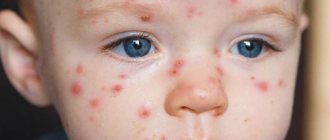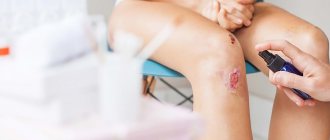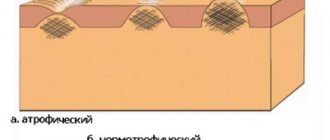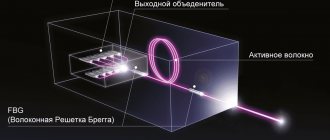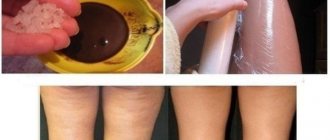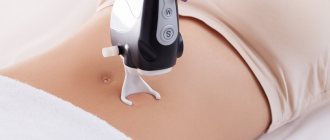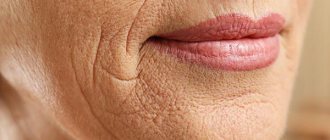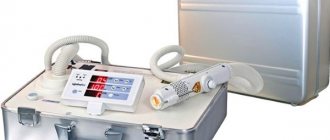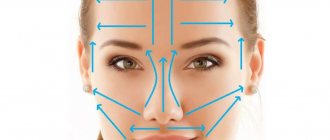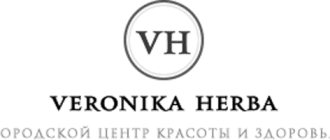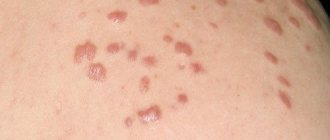A scar is the formation of connective tissue in the area of wound healing. Scars, including those that remain after surgery, do not look aesthetically pleasing, and a person may feel discomfort due to the fact that there are scars on his body. However, with the help of modern medicine, this cosmetic defect can be eliminated.
Laser is used to remove postoperative scars. They are removed using laser resurfacing. The advantages of scar resurfacing include a minimal risk of complications. The maximum effect is achieved from this procedure.
Principle of the laser method
Laser removal of scars and scars is a separate segment of medicine, which includes laser surgery, cosmetology and medicine. Depending on the purpose, different types of lasers can be used.
The main differences between lasers are the following criteria::
- device type;
- flash duration;
- wavelength and spectrum;
- depth of action;
- processing intensity.
The laser acts on the skin in three directions:
- photothermal;
- photochemical;
- photomechanical.
Pulsed lasers help treat nodular tissue. This is ensured by a photothermal effect aimed at cooling. The laser beam heats the scar tissue and promotes its destruction. The effect is very fast, so the skin around the scar is not heated or affected.
Specialists use laser to eliminate nodular formations and create favorable conditions for the growth of new, healthy skin.
Only the subcision method can effectively remove acne scars on the face.
Maxim Vasiliev’s method against acne scars is based on the subcision method - a special microtechnique for cutting scars. This method was first used in 1995 and works great even against the most old and deep atrophic scars.
Subcision is a painstaking method of correcting atrophic post-acne scars.
Subcision is performed under local anesthesia using a powerful microscope. Using a sterile syringe needle, the surgeon carefully and quickly cuts the so-called “strands” - separating the scar tissue from neighboring structures. The skin, which is no longer held in place, rises and straightens.
Advantages and disadvantages
Laser scar removal is a modern technique that has a number of advantages.:
- The procedure is universal and can be used on both light and dark skin.
- The laser allows you to eliminate any skin defects.
- During the exposure process, healthy tissue is not affected.
- No pre-treatment of the leather is required.
- The result will be visible within a few minutes.
- You can easily remove scars in any, even the most delicate places.
- You can return to your usual activities after 1-2 hours.
Among the disadvantages, there is a fairly high cost and the presence of contraindications.
How to treat fresh scars?
To speed up healing and prevent the formation of rough scar tissue, conservative treatment of fresh scars and stretch marks should be carried out. This will allow you to get a neat, tight scar, sometimes almost invisible, which will significantly reduce the number of laser resurfacings. Excellent results are obtained by plasma therapy (plasmolifting), placentotherapy, mesotherapy with anti-inflammatory and defibrosing components in combination with methyl agents for the treatment of scar tissue.
Contraindications
The laser removal procedure is contraindicated in such conditions.:
- malignant neoplasms;
- pregnancy and lactation;
- diabetes;
- skin diseases (dermatitis);
- predisposition to keloids;
- infectious pathologies;
- taking medications that suppress coagulation;
- mental disorders.
The procedure cannot be performed on patients under the influence of alcohol or drugs. Experts advise avoiding it in the summer. High sun exposure promotes the production of melanin in the skin, which can enhance initial pigmentation.
Features of the laser method
Before the session, the specialist examines the skin and selects the appropriate type of treatment. The procedure itself is painless, but given the sensitivity of the skin, the treatment area may need to be anesthetized beforehand. Using a laser beam, a specialist removes the scar layer. Its power and intensity of action are determined by a special program. The whole process takes 20-40 minutes.
Finally, a soothing cream is applied to the skin . At this stage, it needs moisture to replenish its water balance.
To remove scars in cosmetology, two types of lasers are used - neodymium and erbium.
Erbium type of exposure
Erbium laser is used for classical resurfacing . A directed beam of light acts on the scar and destroys the upper part of the skin at a depth of 1 micron. In simple words, the thinnest layer of the dermis evaporates. Thanks to the directed flow of light, liquids evaporate at the cellular level, which activates skin restoration processes.
Renewal at the cellular level will be noticeable after the first procedure. At the same time, the procedure activates blood flow and normalizes lymphatic drainage. The advantage of this method is that there is no risk of hyperpigmentation. It does not affect healthy cells. However, the technique does not remove all scars.
Neodymium exposure type
One of the safest methods with minimal risk of burns during the procedure.
The laser penetrates the skin no more than 2 mm, and contact with healthy cells is excluded. In fact, the technique is a targeted effect on problem areas of scar tissue. The intensity of action and the number of impulses are controlled by a computer . The human factor is excluded. The main advantage of neodymium lasers is the ability to remove scars from various types of skin.
Experts often recommend using two types of lasers.
What types of scars are there?
- Hypotrophic scars. They are located below the skin level and form unsightly pits. Mostly they remain after acne and chicken pox. To remove acne scars, you usually need more than one procedure.
- Normotrophic scars are located at the skin level, their surface differs from the skin in its uneven surface and color. They can be removed in one go.
- Hypertrophic scars. These are scars that often form after a deep cut. They protrude above the general level of the skin. It can be removed with laser polishing several times.
- Keloid scars. Outwardly they look like hypertrophic ones. Typically, such a scar is wider than its base. It may hurt, and the person experiences unpleasant itching. They appear in people whose bodies are prone to forming such scars even after minor cuts.
How many sessions will it take to get rid of scars completely?
The number of procedures required to get rid of scars is determined individually and depends on the size of the defect, its severity, location, and duration of existence. Approximate time frames are as follows :
- Keloid scars become approximately 30% smaller after the first session.
- Hypertrophic scars . They are considered the most difficult to remove. They require repeated sanding.
- Atrophic scars can be eliminated in 1-3 procedures. For deeper damage, longer exposure may be required.
- Normotrophic scars are removed in 1-2 sessions.
According to statistics, to achieve the desired result, a course of laser therapy is needed in 2-10 sessions. The skin needs 3-4 weeks to recover between them, during which no procedures are performed.
Still have questions?
If you have any questions or sign up for a free consultation with a surgeon, please call:
+7 (495) 255−50−11.
| Consultation with a dermato-oncologist surgeon | FOR FREE |
| Excision of scars (per 1 cm incision): | |
| Excision of scars on the body, 1 cm of scar | 3,000 rub. |
| Excision of scars on the face and neck, 1 cm of scar | 5,000 rub. |
| Correction of body scar with local tissues, 1 cm of scar | 5,000 rub. |
| Correction of face and neck scars with local tissues, 1 cm of scar | 10,000 rub. |
| Correction of retracted scars with Collost filler 7% - 1.5 ml | 13,000 rub. |
| Correction of retracted scars with Collost filler 15% - 1.5 ml | 18,000 rub. |
| Spherogel Lights 0.5 ml | 6,000 rub. |
| Spherogel Lights 1.0 ml | 11,000 rub. |
| Spherogel Medium 0.5 ml | 8,000 rub. |
| Spherogel Medium 1.0 ml | 15,000 rub. |
| Scar hormone therapy (Diprospan) | 1,300 rub. |
| Laser resurfacing CO2 1 cm2 | 2,000 rub. |
Photos before and after
The following are photos of skin areas before and after the scar removal procedure:
Collotherapy
Gel Collost is a high-tech biological material, namely collagen of the first type with a completely preserved structure. It is used to correct retracted (hypotrophic) scars. Immediately after administration, the drug creates the missing volume and also activates tissue regeneration in the affected area, triggering the formation of new collagen fibers and improving the quality of the newly formed tissue (greater order of the fibers, greater elasticity).
Scar correction with Collost usually allows you to achieve the desired effect immediately after the first procedure. The drug itself undergoes gradual resorption in tissues, but due to the stimulation of collagenogenesis, the injected collagen is gradually replaced by the body’s own collagen.
Further skin care
The duration of the rehabilitation period after laser scar removal is 3-7 days. In women over 40 years of age, rehabilitation may take 25% longer . The duration of recovery is influenced by the speed of metabolic processes and the hereditary factor.
During the rehabilitation period, you must adhere to the following recommendations:
- For a month you need to stop visiting baths, saunas, and water treatments.
- Do not apply cosmetics or formulations containing alcohol to the skin, or use makeup removers.
- Avoid treating the skin with antiseptics (iodine, brilliant green, etc.).
- It is forbidden to move crusts that appear during healing.
- It is recommended to moisturize your skin regularly. To do this, you can use special cosmetics or sesame or olive oil.
- For 6 weeks after the procedure, it is necessary to protect the skin from ultraviolet radiation and try not to be in direct sunlight.
Surgical correction of scars
Surgical correction of scars is carried out by excision of scar tissue with or without local tissue, followed by the application of a cosmetic suture.
| Scar excision at the Gradient clinic:
| It is recommended to correct a scar older than six months, since the maturation of connective tissue lasts from 4 to 6 months. This technique allows you to reduce the width of the scar, make the scar less noticeable, correct the disturbance of the relief (retractions, tuberosity), remove foreign tissue, and restore mobility to the scar area. |
Possible complications
Complications that can result from laser scar removal are few. Immediately after the procedure, the skin most often turns red, swelling, pain, discomfort and burning appear. They usually go away on their own within 2-3 days.
After 2-3 days, temporary pigmentation may appear on the skin. This is due to the content of dead cells containing pigments in the skin. Itching, dryness, and flaking also occur. These symptoms remain for 7-10 days.
Usually complications go away on their own. If this does not happen after the specified period, you need to consult a specialist. The likelihood of burns during laser removal is practically reduced to zero.
Types of scars that can be removed
These include all types of scars:
- Atrophic . With such lesions, the skin sinks inward, dimples and potholes appear. This is due to the fact that as a result of damage to the integument, the connective tissues react poorly and little collagen production occurs.
- Hypertrophic . Defects resulting from the inflammatory process in the wound. In this case, connective tissue is formed in excess, resulting in a tubercle appearing above the main surface of the skin.
- Normotrophic . The least noticeable traces of damage to the skin, which have a lighter shade compared to the natural skin tone. Unlike other types, they have low sensitivity.
- Keloids . Scars of a pathological nature with an inflammatory process inside. They have a bright color, cause pain, itching and tend to further increase the area of connective tissue - over time it begins to extend beyond the boundaries of the damaged area. Such a scar requires mandatory treatment.
In any case, before carrying out the procedure, an examination and consultation with a doctor is required.
Price of the procedure in Moscow and St. Petersburg
The price of the procedure is determined by a number of factors. This depends on the size, depth, nature of the defect, as well as on the locality and level of the institution where the sessions are held. Average prices for the procedure in Moscow and St. Petersburg:
- Removal of scars and scars (formed after pimples, acne, bites) – 500-1000 rubles per 1 sq. cm.
- The average cost of eliminating keloid scars and atrophic scars is 900 rubles per sq. m. cm.
- Elimination of scars after operations (removal of appendicitis, cesarean section) – 800-1000 rubles per sq. m. cm.
Laser removal of scars is one of the best methods for eliminating skin defects. The procedure is painless and has virtually no complications . To completely remove blemishes, you need to undergo several sessions, and it is important that the procedure is carried out by a qualified specialist.
